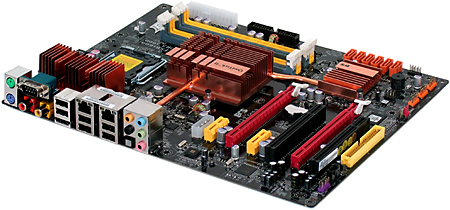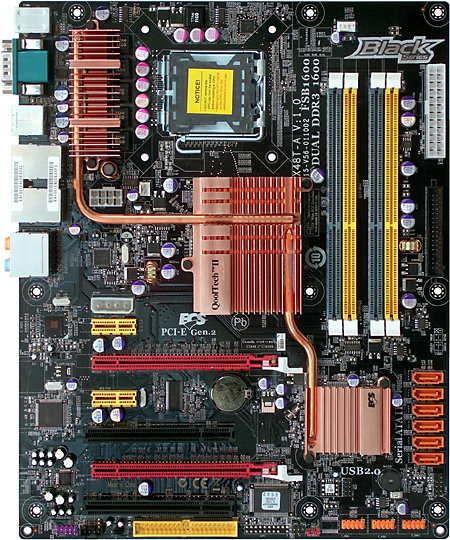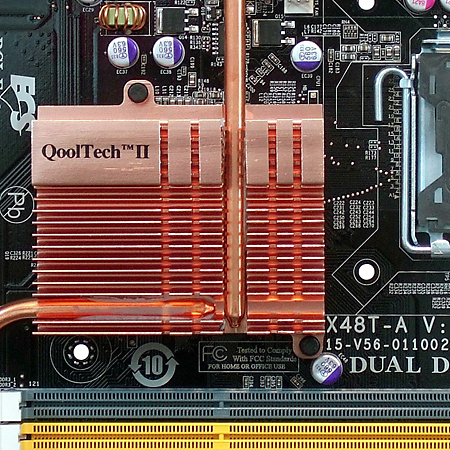X48 Motherboard Comparison, Part 2
ECS Black Series X48T-A
Elitegroup Computer Systems has been at the high end a few times, formerly with its Extreme motherboard series and more recently with Nvidia reference designs. The company is stepping into a new direction in its “Black” series, shunning flashy board colors and noisy fans in an effort to provide enthusiasts what they really want : features, performance and stability.
Layout and Features
ECS really cleaned up the design of its X48T-A, but without removing many features. The most striking design elements include the enormous sinks of the heat pipe assembly, but the southward-positioned DIMM slots draw a second look.
The reason most companies are moving DIMM slots so far down the board is to shorten trace lengths for better memory stability at super-high speeds, but the trade off is loss of room for expansion cards. The X48T-A comes with only six slots, and the uppermost x1 slot is limited to cards no more than 7.1” (180mm) long. The X48T-A comes with only two PCI-Express x16 slots ; the top slot is in the third position on a case ; and both slots provide full PCI-Express 2.0 transfer modes.The elimination of a third x16 slot is no big loss, considering how competing brands are forced to provide theirs with only four lanes (at most) in PCI-Express 1.0 mode, but giving up a useless feature is still a gutsy move when so many buyers ignore practicality. Other expansion options include two PCI-Express x1 and two legacy PCI slots, but only one of each will be available in CrossFire configurations using double-slot cards.
But ECS’ design isn’t quite perfect, as two of its six internal SATA ports can easily be blocked off by the long coolers of double-GPU graphics cards. For buyers who don’t use such monster graphics, the benefit of facing the ports outward rather than forward is that they won’t be blocked by the hard drive cage of snug cases.
Like ASRock, ECS forces builders to stretch their front panel audio cables all the way back to the motherboard’s lower rear corner, which is a commonly used location that should have been done-away with long ago.
Maintaining a clean layout did require ECS to make a more serious compromise of placing the Ultra ATA connector under the lowest PCI slot, where its cable couldn’t possibly reach the upper drive bays of most cases, but the firm probably believes builders will opt for SATA optical drives instead. In the place the Ultra ATA connector “should have been,” we instead found a floppy cable header, which was ideally positioned at the front edge of the board, just above the center line. Many Windows XP users will be grateful that installing a floppy drive for RAID or AHCI drivers has been eased, and we think it’s ironic that the “presumed dead” floppy interface is now outliving Ultra-ATA thanks to Microsoft’s former OS installation requirements.
Get Tom's Hardware's best news and in-depth reviews, straight to your inbox.
Moving back to the giant chunk of aluminum ECS uses to cool the Northbridge, we can see the heat pipes are glued in with thermal adhesive, rather than soldered on. This isn’t a problem as most companies would have you believe, as each of the sinks is generously sized for its specific task. In fact, ECS could have done away with heat pipes entirely, if not for the need to entice uninformed buyers.
-
nihility I thought the major concern with overclocking was doing it with 4 GB or 8 GB of memory installed and with quad cores.Reply
Buying an overly expensive high end motherboard but installing a 65 nm dual core processor and just 2 GB of RAM seems a very odd combination to me. -
@niReply
Not so odd if you want to get the base foundation set up and then wait for lower prices on higher performance parts later on down the road.
A quad core (3.0 GHz x 4) chip is coming down the pike by years end and DDR3 prices are on the slide. Building an E8400 / 2 GB base machine is exactly what I did to finally migrate from my 5 year old P4 Extreme Edition / Intel 875 based rig.
That's the beauty of the X48 platform; longevity. -
The ECS offering has supposedly been out for around a month, but I can't find it for sale ANYWHERE!! can't even find a price. I used to turn my nose up at ECS products. Our company used Asus boards exclusively thinking they were a higher quality product. Evey one of our Asus boards failed within 4 years. This may be because the Chinese have studied the American business model... Make a product that is designed to either fail or need parts within a calculated period of time. ECS are much cheaper, and so far seem more stable than the Maximus Formula board we purchased recently. The Asus BIOS is for people who like to toy with settings. Unfortunately their BIOS has become complicated beyond their programmers ability too write stable code.Reply
-
Glad to see that gigabyte's board was so much more energy efficient than Asus', or any other board for that matter... especially while overclockingReply
-
Fedor Arcolyte - lol. Did you fall asleep and dream up another page of the review which had power consumption whilst overclocking? :pReply
For the record I'm using my first Gigabyte board (X38-DQ6) and overall I'm pretty happy with it, but having said that I haven't used Asus in at least 5 years. With these comparisons it often comes down to features since performance is pretty near (although the low memory speeds achieved by the Gigabyte surprised me!). -
" Intel covers all of its CPU VRM MOSFET?s with sinks. Our apologies for the alphabet soup that made up the last comment. " -> You could've gone with " Central Processing Unit Voltage Regulator Module Metal?Oxide?Semiconductor Field-Effect Transistor's " , so it's ok =)Reply
-
frodbonzi I wonder how the Asus' Rampage Formula stacks up here? It supports DDR2 or DDR3 and is part of the RoG line... X48 as well...Reply -
xanxaz asrock rocks....lol...although i'll keep my gigabyte... as i dont know where to say this, it's better say it here... your main page is eating my cpu cycles... between 25% up to 50% cpu utilization while viewing your site? please cut down in animated ads... running a c2d at 3.6 and still lags while surfing... dah... it's just your site... os is it me? i think it's the ad on the top right corner that is causing that...Reply -
wozeus I see that Newegg has ECS X48T-A for under $200. Looks like it's a great deal...going to get one.Reply




